I was in a car accident when I was 13 that claimed the lives of my father and sister. It also severed my spinal cord at the fourth thoracic vertebra, leaving me paralyzed from the chest down. I have moved around in a wheelchair for nearly 41 years now.
After the accident, I was told I would have no body awareness below the point of injury. In some ways, this is true: If I tickle the bottoms of your feet, you can feel it. If you tickle the bottoms of my feet, I do not.
It turns out, however, there are other levels of body awareness that are still possible within our mind–body relationships. For me, the traumatic event that resulted in the loss of physical sensation on my “outer” body — touch on my skin, the feeling of flexing muscles, the ability to feel direct physical pain — also uncovered another, deeper level of potential sensation.
My loss wasn’t just loss; it was also a discovery, revealing something I didn’t know was inside me. It took time.
I eventually started practicing yoga at age 25 as a way to find peace and healing. The practice inspired me, and for the past 28 years, I have been studying the potential for sensation between mind and body, even in situations when it’s easy to believe all is lost.
In 2002 I founded Mind Body Solutions to help people and their caregivers transform trauma, loss, and disability through deepening the connection between mind and body. Simply put, my team and I help people live more vibrantly in the only body they will ever have.
In doing so, we’ve become experts at deepening body awareness and experiencing its implications firsthand. We’ve learned that everyone can benefit from increased body awareness, and that movement — which includes but isn’t limited to your formal workouts — is an important access point.
In other words, you can bring more awareness, feeling, and sensation to any movement. This can help you enhance the results of your workouts, including improved performance, and increase awareness in other areas of your life.
By occasionally transforming your exercise routine into a more conscious mind–body practice, you can experience physical benefits. Tune in to your body, and you can make your workout safer and improve your technique.
This body awareness will also help you realize benefits beyond the physical. It can lead you to find more grounding in your daily life and create better boundaries; it can shield you from stress, calm your mind, and make you more patient with others.
Your body holds wisdom and offers important feedback on how you’re moving and living. Your body is not just an object to overcome — it is a crucial, responsive aspect of who you are.
Reimagining Your Workouts
There are many ways to work out. Perhaps you use exercise to disconnect from the outside world, blow off steam, and burn off stress. While exercising, maybe you listen to music or a podcast, watch television, read a magazine, or let your mind go completely blank.
Or maybe you’re more of a pusher, striving to achieve your next PR — so much so that you stop listening to your body. Maybe you even seek to overcome your body. Maybe you believe in the adage “No pain, no gain.”
There is nothing wrong with these approaches. But there is a third way: Tune in to your body awareness, rather than tune out, and let it guide you.
To better understand body awareness and how we experience it, you can make some distinctions. You may not have thought about these distinctions explicitly, but you live them every day.
Consider the differences between thinking about your finger, looking at your finger, and moving your finger. If you close your eyes and think about your finger, it is difficult to locate where it is in space. But when you think about and look at your finger simultaneously, you are able to locate it visually in space while having thoughts about it.
Notice now, when you move that same finger: It becomes located through direct sensation. Similarly, when you touch something, like a drinking glass, the physical movement is further supplemented by input into your finger from the glass.
I invite you to think of these practices as more than strictly mechanical. Good technique and better physical alignment will increase your body awareness.
These are examples of proprioception. There are receptors in your muscles and joints that tell your brain where you are in space.
When walking, you know that your foot is off the ground without having to think about it. You feel it and it does not require any mental judgment. Your body is wired so the brain receives this information directly.
Interoception is similar, except that the receptors are in your organs, including your skin. These receptors relay information to your conscious as well as subconscious brain to help regulate vital life functions, including thirst, hunger, digestion, heart rate, and body temperature. At a basic level, interoception tells you what’s happening inside your body — when you’re hot, cold, itchy, or ticklish, or when you need to take a deep breath.
There are other forms of body awareness: pain, pleasure, the sensation of relief, the feeling of rhythm, a sense of safety and comfort, and more. When you combine all these things with proprioception and interoception, the body–brain connection becomes an effective and robust system to sense and interact with the world.
You have likely already integrated mind–body practice in your fitness routine — perhaps unknowingly. Experimenting with your breathing is one example: You may have discovered when it is more powerful to inhale through your nose and when it is necessary to breathe through your mouth. Likewise, learning better running mechanics or weightlifting techniques is an investigation into increased body awareness.
I invite you to think of these practices as more than strictly mechanical. Good technique and better physical alignment will increase your body awareness. For example, engaging your legs to lift a kettlebell doesn’t only protect your back. It has the added benefit — for many people, the hidden benefit — of spreading awareness throughout your body and making your whole system work in unison.
Practicing Integrated Awareness
While you may have inadvertently improved your body awareness by experimenting with your breath and body mechanics, I invite you to intentionally practice expanding it — to widen your conception of your workout by occasionally including a more conscious connection between mind and body.
Let’s break down two instances when you can turn an activity into an integrated mind–body exercise.
Running
Repeating the same basic stride and movements again and again, running allows you to find a rhythm and zone out. This in turn opens up opportunities to work through stress, solve problems, and achieve that euphoric runner’s high.
But chronic repetition is a slow-burning form of mistreatment. This partly explains why many runners deal with numerous physical ailments, including shin splints, joint pain, back soreness, worn ligaments, sore feet, and blisters.
Boosting body awareness can help you shorten recovery time and avoid injury. While it may slow you down at first, running with increased awareness will, over time, integrate with your running habits. Eventually, it may speed you up by improving your technique.
Next time you run, try adding a new dimension of body awareness:
- Notice that if you look down while running, your feet tend to land heavier and with more force. Instead, look straight ahead, even upward.
- Open and broaden the center of your chest by becoming more aware of it.
- See if you can keep a lighter feeling in your hips and pelvis while also staying aware of a subtle connection to your heels and feet.
- Try to relax your hands and fingers, and avoid clenching them into a fist.
- Become more aware of the bottoms of your feet — how they hit the pavement, how they lift off. Keep a sense of lightness and inwardly open your chest as your feet hit the pavement; lift from the bottoms of your feet as they rise. Notice the changed feeling in your legs and chest.
- Run with a deepened sense of wholeness, feel the outline of your entire body through your skin, and experience your breath in rhythm with the space around you.
Weightlifting
The bench press is a common lifting exercise that offers great potential benefits. But benching has a reputation as a mindless exercise that can result in shoulder injuries. Paying close attention can offset these hazards.
This extra awareness may at first require decreasing the amount of weight you’re lifting. But remember, the goal is to occasionally practice integrated awareness, not to generate maximum physical output.
Next time you bench press, try to integrate the following mind–body cues:
- Make sure that your feet are planted squarely on the floor, paying extra attention to your heels, especially the inner edges. Feel the change in your lower abdomen.
- As you push up against the bar, draw your abdomen down and spread your midback gently into the bench.
- Keep your sternum light as you lift the weight upward while also grounding your legs and feet.
- Stay grounded and alert as you lower the bar.
- Lift and lower the weight with your full body and mind and a deep sense of integrated movement. Notice how the mindlessness associated with lifting is gone.
In any activity you love, focus your attention instead of letting it wander. As you do so, ask yourself: What do I notice? What happens when I make this change? The insights may be illuminating, but the key is simply noticing in the first place. Noticing — no judgments or conclusions required — builds awareness.
Increasing body awareness is something you can work into your existing workout regimen — not as a better way, but as a complement. You might zone out sometimes, push yourself sometimes, and practice with increased body awareness sometimes. Aim for a balance that’s right for you.
See Benefits in Your Workouts — and Beyond
Practicing body awareness while you work out can teach you many things. An increased mind–body connection can reduce exercise’s physical wear and tear and, over time, improve your performance by supporting efficiency, efficacy, and recovery. It can provide a tangible way to deepen your participation and sharpen your inward focus.
But the benefits extend beyond your fitness regimen. When you consciously learn that there is an “inside” and “outside” to all physical action — when you increase both your proprioceptive and interoceptive body awareness during workouts — you may find that your overall resilience also improves.
When you consciously learn that there is an “inside” and “outside” to all physical action — when you increase both your proprioceptive and interoceptive body awareness during workouts — you may find that your overall resilience also improves.
You might discover that you don’t have to burn off as much stress during your workouts because you haven’t absorbed as much in the first place.
Increasing body awareness can help you become more receptive to support from those around you. At the same time, you may become more supportive of others.
Practicing the skill of noticing can bolster your appreciation of beauty in the world around you and increase your patience and kindness.
Body awareness can make it feel like your life is slowing down a little, like you have space where there previously was none.
Then it happens: You start to realize that your body is and always has been the best home your mind will ever have. You may even start to feel grateful.
This may seem hard to believe. I wouldn’t have believed it before my accident, before I took up yoga and discovered the deeper levels of body awareness I could still access. So don’t take my word for it. Try building your body awareness, pay attention, and watch yourself transform.
3 Moving Meditations
Three stretches to help you increase your body awareness.
Moving the body with awareness in a way that integrates the parts of us that connect our insides to the outside — including our feet, our skin, and our breath — is a way to access a sense of inward calm and to form deeper connections to everything around us, says Matthew Sanford.
“Moving meditation is learning about the intersections of the body, the mind, and the world around us,” he explains. “Presence in the body is a fundamental change agent because it teaches you where you end and the world begins.”
The following moves can help you feel grounded, lighter, and more energized. Sanford suggests progressing through all three and then going back to repeat the first two. Spend at least a few breaths in each pose before moving on to the next.
1) Grounding
By grounding your hands and feet, you will calm your brain, explains Sanford.
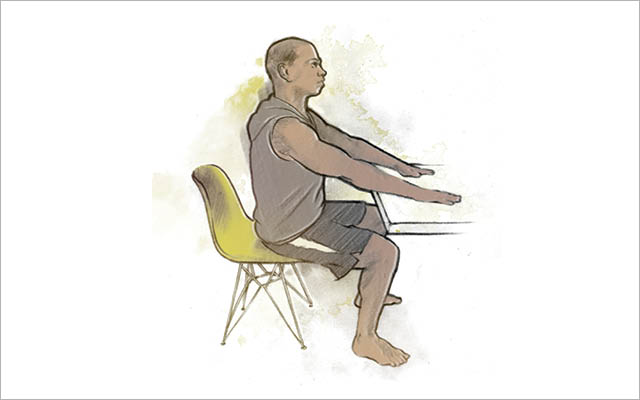
- Sitting at a table, come onto your sit bones at the edge of your chair, with feet directly below your knees.
- With straight arms, place your hands on the table.
- From the center of your palms, extend out through each finger while grounding your sit bones and extending from your inner groin to your inner knee.
- Breathe.
- Lift your sternum to spread awareness through your whole body.
- Breathe.
2) Extending
With this pose, you lengthen your spine, which will give you more energy.
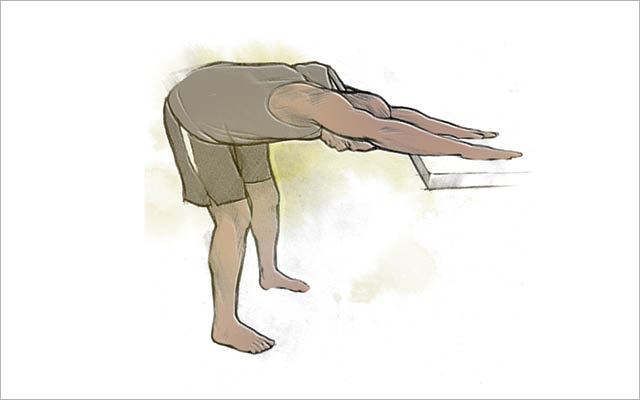
- Standing, place your hands on the table.
- Take a big step back and create a 90-degree angle with your body, your feet under your hips, knees soft.
- Lift your kneecaps up while grounding your heels.
- Make space in your spine: Extend through your sit bones and in the opposite direction through the top of your head.
- Breathe. Feel your breath go into your spine. Inhale to expand. Exhale and extend through the spine with active legs.
3) Expanding
The expansion in this pose gives a sense of embodied empowerment. Don’t be afraid to take up space by spreading your arms and legs wide.
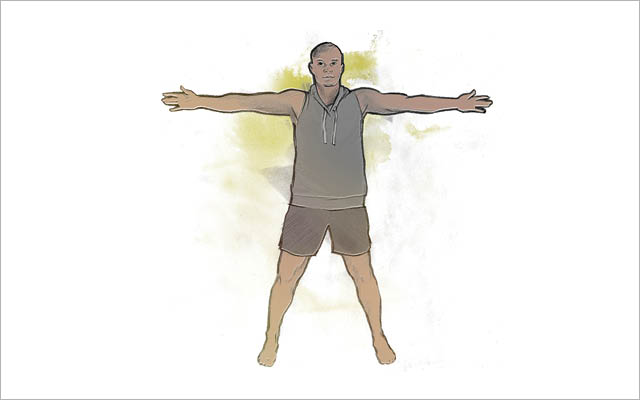
- Stand with your arms wide and your legs 3½ to 4 feet apart, with feet pointed forward.
- Pick a point in the center of your chest and extend from there through your arms, keeping your legs active. Consciously breathe across your whole diaphragm. Keep getting bigger in space.
- Inhale to expand. On each exhalation, extend farther into the pose.
- When finished, slowly move to standing with your legs together and your arms at your sides.
— By Amy Gunty, CES, PES
This originally appeared as “Tuning In” in the April 2020 print issue of Experience Life.
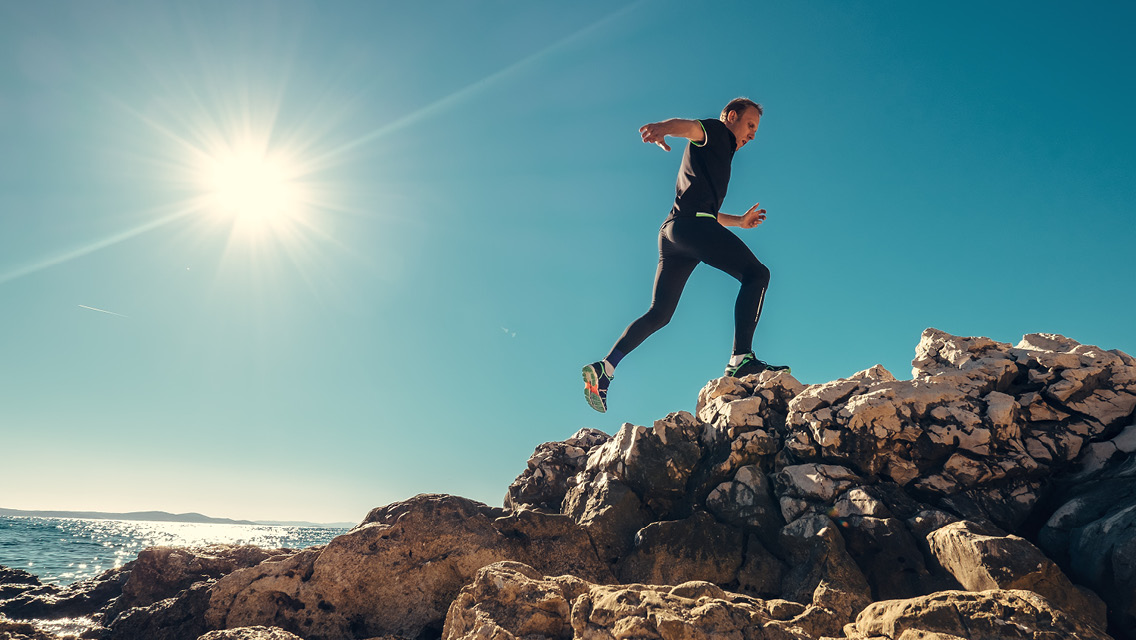
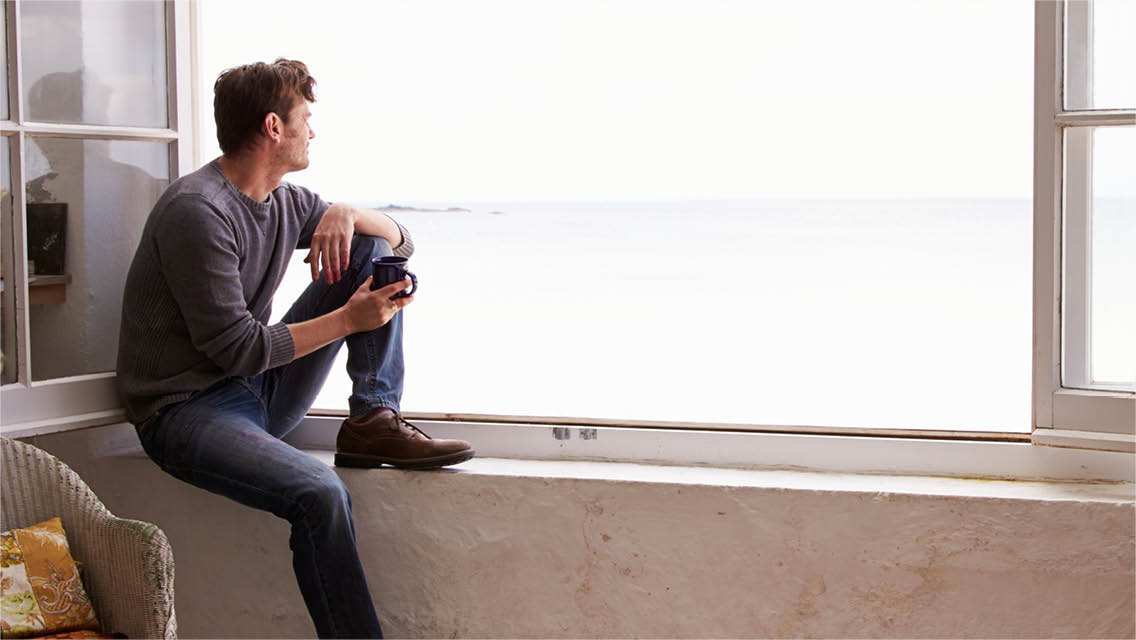

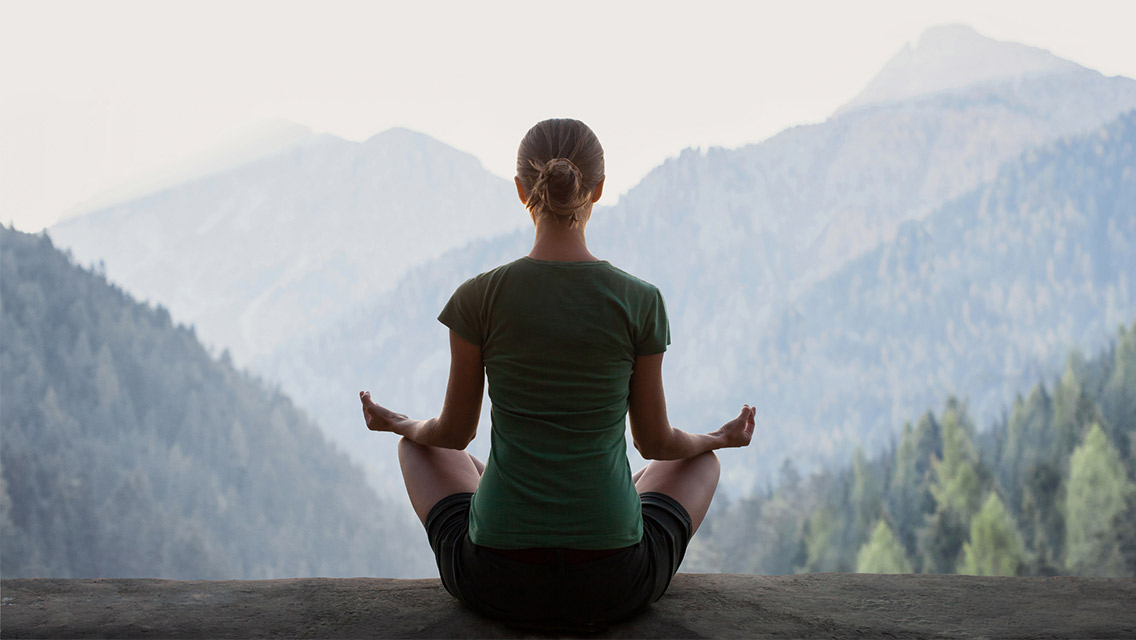
This Post Has 0 Comments